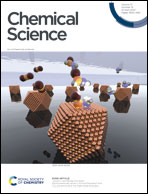Hydridotetrylene [Ar*EH] (E = Ge, Sn, Pb) coordination at tantalum, tungsten, and zirconium†
Abstract
In a reaction of tantalocene trihydride with the low valent aryl tin cation [Ar*Sn(C6H6)][Al(OC{CF3}3)4] (1a) the hydridostannylene complex [Cp2TaH2–Sn(H)Ar*][Al(OC{CF3}3)4] (2) was synthesized. Hydride bridged adducts [Cp2WH2EAr*][Al(OC{CF3}3)4] (E = Sn 3a, Pb 3b) were isolated as products of the reaction between Cp2WH2 and cations [Ar*E(C6H6)][Al(OC{CF3}3)4] (E = Sn 1a, Pb 1b). The tin adduct 3a exhibits a proton migration to give the hydridostannylene complex [Cp2W(H)![[double bond, length as m-dash]](https://www.rsc.org/images/entities/char_e001.gif) Sn(H)Ar*][Al(OC{CF3}3)4] 4a. The cationic complex 4a is deprotonated at the tin atom in reaction with base MeNHC at 80 °C to give a hydrido-tungstenostannylene [Cp2W(H)SnAr*] 5a. Reprotonation of metallostannylene 5a with acid [H(Et2O)2][BArF] provides an alternative route to hydridotetrylene coordination. Complex 4a adds hydride to give the dihydrostannyl complex [Cp2W(H)–SnH2Ar*] (7). With styrene 4a shows formation of a hydrostannylation product [Cp2W(H)
Sn(H)Ar*][Al(OC{CF3}3)4] 4a. The cationic complex 4a is deprotonated at the tin atom in reaction with base MeNHC at 80 °C to give a hydrido-tungstenostannylene [Cp2W(H)SnAr*] 5a. Reprotonation of metallostannylene 5a with acid [H(Et2O)2][BArF] provides an alternative route to hydridotetrylene coordination. Complex 4a adds hydride to give the dihydrostannyl complex [Cp2W(H)–SnH2Ar*] (7). With styrene 4a shows formation of a hydrostannylation product [Cp2W(H)![[double bond, length as m-dash]](https://www.rsc.org/images/entities/char_e001.gif) Sn(CH2CH2Ph)Ar*][Al(OC{CF3}3)4] (8). The lead adduct 3b was deprotonated with MeNHC to give plumbylene 5b [Cp2W(H)PbAr*]. Protonation of 5b with [H(Et2O)2][Al(OC{CF3}3)4] at −40 °C followed by low temperature NMR spectroscopy indicates a hydridoplumbylene intermediate [Cp2W(H)
Sn(CH2CH2Ph)Ar*][Al(OC{CF3}3)4] (8). The lead adduct 3b was deprotonated with MeNHC to give plumbylene 5b [Cp2W(H)PbAr*]. Protonation of 5b with [H(Et2O)2][Al(OC{CF3}3)4] at −40 °C followed by low temperature NMR spectroscopy indicates a hydridoplumbylene intermediate [Cp2W(H)![[double bond, length as m-dash]](https://www.rsc.org/images/entities/char_e001.gif) Pb(H)Ar*]+ (4b). Hydrido-tungstenotetrylenes of elements Ge (5c), Sn (5a) and Pb (5b) were also synthesized reacting the salt [Cp2W(H)Li]4 with organotetrylene halides. The metallogermylene [Cp2W(H)GeAr*] (5c) shows an isomerization via 1,2-H-migration to give the hydridogermylene [Cp2W
Pb(H)Ar*]+ (4b). Hydrido-tungstenotetrylenes of elements Ge (5c), Sn (5a) and Pb (5b) were also synthesized reacting the salt [Cp2W(H)Li]4 with organotetrylene halides. The metallogermylene [Cp2W(H)GeAr*] (5c) shows an isomerization via 1,2-H-migration to give the hydridogermylene [Cp2W![[double bond, length as m-dash]](https://www.rsc.org/images/entities/char_e001.gif) Ge(H)Ar*] (9), which is accelerated by addition of AIBN. 9 is at rt photochemically transferred back to 5c under light of a mercury vapor lamp. Zirconocene dihydride [Cp2ZrH2]2 reacts with tin cation 1a to give the trinuclear hydridostannylene adduct 10 [({Cp2Zr}2{μ-H})(μ-H)2μ-Sn(H)Ar*][Al(OC{CF3}3)4]. Deprotonation of 10 was carried out using benzyl potassium to give neutral [({Cp2Zr}2{μ-H})(μ-H)μ-Sn(H)Ar*] (11). 11 was also obtained from the reaction of low valent tin hydride [Ar*SnH]2 with two equivalents of [Cp2ZrH2]2. The trihydride Ar*SnH3 reacts with half of an equivalent of [Cp2ZrH2]2 under evolution of hydrogen and formation of a dihydrostannyl complex 13 [Cp2Zr(μ-H)SnH2Ar*]2 and with further equivalents of Ar*SnH3 to give bis(hydridostannylene) complex [Cp2Zr{Sn(H)Ar*}2].
Ge(H)Ar*] (9), which is accelerated by addition of AIBN. 9 is at rt photochemically transferred back to 5c under light of a mercury vapor lamp. Zirconocene dihydride [Cp2ZrH2]2 reacts with tin cation 1a to give the trinuclear hydridostannylene adduct 10 [({Cp2Zr}2{μ-H})(μ-H)2μ-Sn(H)Ar*][Al(OC{CF3}3)4]. Deprotonation of 10 was carried out using benzyl potassium to give neutral [({Cp2Zr}2{μ-H})(μ-H)μ-Sn(H)Ar*] (11). 11 was also obtained from the reaction of low valent tin hydride [Ar*SnH]2 with two equivalents of [Cp2ZrH2]2. The trihydride Ar*SnH3 reacts with half of an equivalent of [Cp2ZrH2]2 under evolution of hydrogen and formation of a dihydrostannyl complex 13 [Cp2Zr(μ-H)SnH2Ar*]2 and with further equivalents of Ar*SnH3 to give bis(hydridostannylene) complex [Cp2Zr{Sn(H)Ar*}2].
![Graphical abstract: Hydridotetrylene [Ar*EH] (E = Ge, Sn, Pb) coordination at tantalum, tungsten, and zirconium](/en/Image/Get?imageInfo.ImageType=GA&imageInfo.ImageIdentifier.ManuscriptID=D2SC00297C&imageInfo.ImageIdentifier.Year=2022)
- This article is part of the themed collections: 2022 ChemSci Pick of the Week Collection and 2022 Chemical Science HOT Article Collection


 Please wait while we load your content...
Please wait while we load your content...